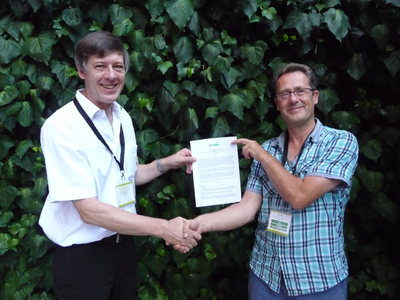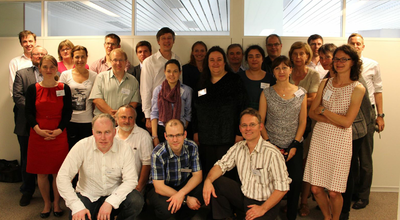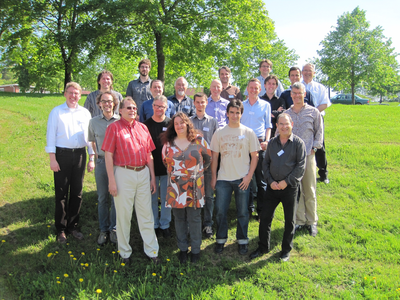At the Bioinformatics Horizon 2013 Conference (3 - 6 September 2013, Rome) a Memorandum of Understanding was signed between PESI and EU BON. Christoph Häuser, on behalf of EU BON and Yde de Jong on behalf of PESI (see picture below), signed the document to strengthen the cooperation and formalise the integrating efforts of the European species infrastructures.
PESI is now a new associate partner of EU BON, a consortium with currently 30 partners from 18 countries. One of the common aims of EU BON and PESI will be to establish and sustain standard taxonomies for Europe. EU BON will support the PESI backbone developments, including its components, with a focus on Fauna Europaea and Euro+Med. Besides analyzing current gaps, new ideas will be developed to trigger expert involvement and enhance the data management systems.
In a side-meeting at BIH 2013, some ideas were discussed with available EU BON and PESI partners. Important steps will be taken to secure the sustainability of databases and expertise networks combined with the development of technical innovations for users and stakeholders and to promote the implementation of PESI as a European (INSPIRE) standard. It will be also important to further integrate the huge expertise networks, outreach to PESI Focal Points and expand the geographical scope. Furthermore, it will be important to integrate additional data types and data-resources.
 Memorandum of Understanding was signed by Christoph Häuser, on behalf of EU BON and Yde de Jong on behalf of PESI
Memorandum of Understanding was signed by Christoph Häuser, on behalf of EU BON and Yde de Jong on behalf of PESI
The first EU BON Stakeholder Round Table was held on 18 June 2013 at the Leibniz Association in Brussels, under the motto "Requirements for Policy".
Important topics regarding biodiversity information were discussed with political stakeholders and a variety of valuable recommendations were given for the future process of EU BON. Among the participants were members of the European policy, representatives of recent European biodiversity projects and EU BON members. At the round table, intensive discussions took place regarding what biodiversity policy needs, like which indicators and measurements are needed to answer burning policy questions. Suggestions were made to formalize Essential Biodiversity Variables (EBV’s) and Aichi targets. A future approach was set towards producing a guideline and timeline for indicators that should be established within EU BON.
The challenges of future research policy were also discussed and the collaboration of EU BON with the Group on Earth Observations (GEO) will be a substantial part of the continuous contributions to the global process. EU BON should also serve as a showcase for the European Commission in this respect. EU BON will also be responsible for answering crucial questions regarding data policy, e.g. how to establish a general repository for a long-lasting storage of data and how to handle ‘big data’. Another future task will be to integrate EU relevant projects and initiatives and their data portals, datasets and metadata.
At the round table it was also discussed how public stakeholders can be involved in the future, particularly citizen scientists, so that they could be integrated in EU BON and provide useful information for scientists and researchers.
Among the participants were representatives of major biodiversity stakeholders including Gilles Ollier, Jane Shiel and Sofie Vandewoestijne - European Commission, DG Research and Innovation; Anne Teller - European Commission, DG Environment; Georgios Sarantakos - GEO Secretariat; Cigdem Adem - European Environment Agency; representatives of recent European biodiversity projects (FunDiv, BioFresh, STEP and INSPIRE) and EU BON members.
Presentations:

The Norwegian Biodiversity Information Centre (NBIC) was host to an international biodiversity informatics workshop May 29th-31st. The event was held as part of the EU-project European Biodiversity Observation Network (EU BON), where NBIC is a partner.
The theme for the ‘EU BON Initial Informatics Workshop’ was data architectures, standards and interoperability (improving flow of information between systems). The event gathered renowned international and national experts within data structures for biological data.
EU-project for better data flow
NBIC is the Norwegian partner in EU BON, an EU-project spanning 5 years where 30 institutions from 18 countries contribute. The objective is to build an infrastructure that improves the flow of biodiversity data in all of Europe. Furthermore, the project is a European affiliate to its global counterpart (GEO BON) and will contribute to the work of the newly established ‘Intergovernmental Platform on Biodiversity and Ecosystem Services’ (IPBES).
Good solutions showcased
Worldwide, a large number distinct standards and solutions for management of data on species and nature types exist, and one of EU BON’s objectives is to find solutions to get all of these systems to communicate with one another. Several attendees contributed with presentations highlighting diverse standards and solutions for interoperability. Additionally, four international players in the field of biodiversity informatics presented general international initiatives, projects and services relevant to EU BON.
What is biodiversity informatics?
Biodiversity informatics is the field of applying IT techniques to improve management and presentation of biodiversity information, making it easier to discover, use and analyze such data.
The first EU BON Stakeholder Round Table is now approaching. The workshop will take place in Brussels on 18 June 2013 and be hosted by the Leibniz Association. A main obstacle to reach the 2010 biodiversity goals and to implement the European Biodiversity Strategy is the lacking integration of biodiversity aspects into political, economic, and management decisions in different sectors mainly due to knowledge gaps. The aim of the 1-day workshop will be to identify existing gaps, determine current needs regarding biodiversity information and develop solutions to overcome the existing knowledge gaps within the EU BON project.
EU BON will provide access to biodiversity information that is reliable, relevant, up-to-date, and publicly available. In the first Stakeholder Round Table, the EU BON approach for establishing a European Biodiversity Observation Network will be outlined. Based on that introduction, existing approaches that compile biodiversity or biodiversity-relevant data and the possible synergies and possible contributions to EU BON will be discussed. Another important aspect of the meeting will be to highlight the link to policy and governments of the European Union and their specific needs regarding biodiversity information.
Results of this first stakeholder round table will be documented and passed back to the project in order to increase its relevance. Next stakeholder round tables can be used to evaluate the progress of the project with regard to serving the demands of EC, EEA, GEO BON, IPBES, JRC and other stakeholders.
The first Informatics Workshop of the EU-FP7 funded project EU BON was held on 29-31 May 2013 in Trondheim, Norway. The meeting was hosted by the EU BON partner Norwegian Biodiversity Information Centre (NBIC). The aims were to highlight the link to infrastructures and processes like GEOSS or DataONE and to discuss the data standards and informatics architecture that will be followed by the EU BON project.
During the three-days of the workshop, the participants of the meeting discussed the important aspects regarding the informatics architecture and decided on the next steps to develop a new open-access platform for sharing biodiversity data and tools in order to advance the European biodiversity knowledge. On the first day, the aim was to highlight the link of EU BON with GEOSS, GEO BON and other processes like DataONE to find synergies and to build on work that was conducted in these processes. On the second day, detailed discussion on the specific tasks of the workgroup took place. The afternoon session was split into 3 different tracks where issues like architectural design, review and guidelines for using data standards, the design of monitoring sites and the gap analysis of existing biodiversity data were analyzed and discussed.
It was agreed that a new platform is needed which should be built on existing solutions. Thus, the platform will use the technical solutions of the DataONE network that will be adjusted to the specific needs of the EU BON project. EU BON Partners will implement DataONE Member Nodes to start the process and a DataOne coordinating node may be established towards 2015. Furthermore, it was also decided to join and support the GEO BON Working Group pilot project on automating the data flows for the Essential Biodiversity Variables.





 RSS news
RSS news
 Agenda- First EU BON Stakeholder Round Table
Agenda- First EU BON Stakeholder Round Table
